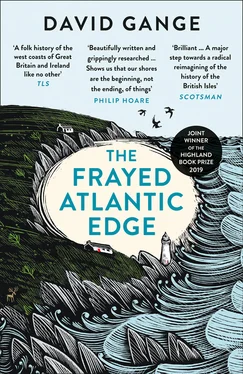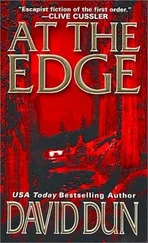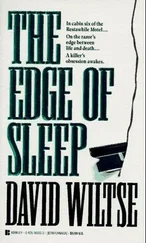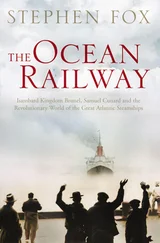In this atmosphere of renewed self-confidence, some Shetlanders, such as the dialect poet William Porteous, began to use English to evangelise the islands to those mainlanders who, if they thought of Shetland at all, pictured a dreary scene. Poetry ‘advertising’ Shetland to the urban south embraced a flamboyant romantic aesthetic that wouldn’t have been possible a century earlier. This marks, perhaps, the beginning of the idea that Shetland is the northernmost and fiercest expression of a frayed Atlantic edge worth celebrating. Ferocious storms, wind-whipped seas and bleak, unpeopled headlands could be romanticised, rather than being dismissed as incompatible with progress or politeness. In Porteous’s descriptions of the ‘strange exultant joy’ to be found in confronting ocean weather, many touchstones of later evocations of the North Atlantic sublime can be found.
Two days after completing my descent of Shetland I found Porteous’s verse in the local archives and was struck by his heroic efforts to make storms not just poetic, but an actual tourist draw. I felt that, having kayaked this far in improbably blissful calm, I still lacked a crucial aspect of the Shetland experience. But there was no need to have worried: five days after I rounded Sumburgh Head a brief but grisly weather front was forecast. I’d already decided, thanks to Sally Huband’s influence, that my last Shetland venture had to be to Foula. Given the risk of rough weather I chose not to paddle the crossing but booked my kayak onto the twice-a-week passenger ferry. At thirty feet long this is essentially just a diesel sixareen with a lid. It was perhaps surprising that only the youngest of the eight passengers was sick as, rocking and rolling, we meandered a slow course across the sea’s contours. Minutes after disembarking in Foula’s tiny harbour I launched the kayak and was paddling up the island’s east coast. By the time I reached the north-east corner, I was in a sea terrorised by breakers three times my height, from which I could look east to the whole Atlantic coast I’d paddled down. That night I wandered through the Foula coastline’s meadows of ground-nesting seabirds, taking great care to find myself a spot to sleep away from any chicks (figure 2.7).
It was on the second of my three days on the island that I finally met the force that Porteous had pronounced Shetland’s true ruler: the ‘Storm King’. That morning I’d climbed the island’s tallest cliffs and lounged, lodged among puffins, with my feet dangling 1,200 feet over the sea (figure 2.8). I sat gazing north while clouds gathered in the west and large, cold drops of water began to fall. Hundreds of screeching kittiwakes took to the air, disturbed by eddies in the wind, while spindrift skimmed the sea in all directions. The real arrival of the storm was preceded by minutes of strange, thick warmth. Then lightning flashed across the ocean, lending the swell fleeting new patterns of light and shadow, before rich, deep thunder reverberated through the rock. Puffins and fulmars joined the kittiwakes in panicked flight, and the booming cliffs themselves seemed to have come to life. The whole spectacle was as sublime and life-affirming as Porteous had, a century before, promised his urbane readers it would be:
And when the Storm King wakes from his sleep in the long, long winter night,
And, robed in his garment of silver spray, strides southward into the light –
At the sound of his voice ye shall see the waves race in for the land amain,
Then, broken and beaten on cliff and beach, fall back to the sea again.
Ye shall see the tide-race rise and rave, and rear on his thwarted path,
Till stack and skerry are ringed with the foam of the hungry ocean’s wrath.
Ye shall watch with a strange, exultant joy, the winds and waters strive,
And your hearts shall sing with the rising gale, for the joy that you are alive. 18
Thermometer and barometer measure our seasons capriciously; the Orkney year should be seen rather as a stark drama of light and darkness.
George Mackay Brown

LATE SUMMER BRINGS uncertainty. It was mid-August by the time I resumed my journey and, in contrast to the long calm days on Shetland, the Orcadian sea changed hour by hour. Sun, squall, sea mist, rain and rainbow passed across the coastlines fast enough to make each morning feel like a time-lapsed month. When winds shifted, water responded: weather was conducted through the shell of the boat and into me, dictating the experience of each new stretch of coast. Not just perception but emotion drifted with the moods of sky and sea. This ranged from the giddy joy of lurching along, propelled by a following swell, or the anxious focus when gusts brought side-on breakers, to serenity on flat seas that seemed perfectly safe and infinitely spacious.
Phases of transition from calm to chaos were often the most sublime, binding beauty and fear together. Not for nothing are the islands of Orkney said to evoke sleeping whales: they are peaceful mounds with awful potentials. As the month progressed I saw, felt, and, for the first time, photographed, parts of waves that seemed more the habitat of surfers than paddlers. These were not the long strafing breakers that come with heavy swell (I still had some leeway before the truly wild weather of autumn); they were the standing waves that twist and coil over any obstacle to a running tide.
Atlantic waters are deceptive in changing weather. In the midst of a tidal maelstrom, hospitable seas can seem beyond the reach of imagination; yet unseen gentleness might be just a few wave crests away. This was driven home to me at the north-west corner of the island of Rousay, where the sea’s tidal features are named with the detail of a city suburb’s streets. Here, emerging from a tide race called Rullard’s Roost I hit a mesh of tide and swell so fierce that I had to head for shore: I thought my day was done within an hour of setting out. Yet five minutes later a more coastal line allowed me through: I could barely see evidence of conditions to cause concern. Much of successful kayaking is in the choice of routes between the shifting waves. As important on the water as arms or balance is a cool head through the roaring, swirling, chilling and grinding that batter the senses in a threatening sea.
Not just the weather, but also the landscapes were now defined by contrasts. On the first islands I passed, transitions from thundering cliffs to the placid undulation of cattle farms are sudden yet somehow seamless. No single landscape lasts more than a few hundred yards. On the most north-westerly island, Westray, the imposing, sixteenth-century edifice of Noltland Castle looms over a large modern farm; seen from the sea, the two occupy the same small space. Beside them, near the spot where surf meets sand, a sprawl of tyres and polythene marks a recently excavated sauna, built by the island’s Bronze Age inhabitants.
This landscape looks at once spacious and cluttered. Centuries and functions, whether sacred, industrial, defensive or recreational, are pushed together at sparsely situated sites. Around them, in wide fields that are almost moorland, the earth is loaded with low-lying detritus of millennia. When I wandered ashore, I found myself watching each inch of ground for traces of the past until every broken plastic bucket or scrap of rope became an artefact. The sounds of breakers, cattle, lapwings, tractors and voices also took on that character: items in the soundscape felt as distinctive of this place as did objects in the landscape.
After making my way north by roads and ferries I had kayaked out from Pierowall, Westray’s capital village. Its small grey buildings perch around a colourful little bay: tall yellow hawksbeard flowers and bronze kelp line an arc of golden sands and green sea. Pierowall was known to the Norse as Höfn and a row of pagan graves suggests it was a Viking-era market. When Rognvald Kali Kolsson stopped here there was a clashing of cultures: he met Irish monks whose hairstyles he mocked in verse. This pretty, ancient port was my place of departure but it wasn’t northerly enough to be my true starting point.
Читать дальше













